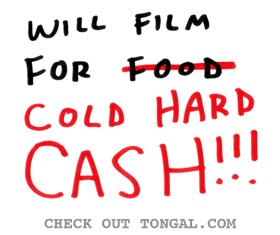Beardy’s Note: Here now is Part III of Cinematographer Jeremy Applebaum’s Three Part Low Budget Lighting guide. In case you missed the first two installments you can read them here: (Part I) (Part 2) Big thanks to Jeremy for creating this very handy guide. Remember, if you have an idea for a Guest Post of your own, be sure to send me an e-mail at . And now, on to Part III…..
First here are the answers to the questions from Part II:
1: 4.16 (dived by volts = 120) or 5 (dived by volts = 100). 2: 2. 3: Yes. 4: No, Around 3.74, largely depending on how you round (dived by volts = 120) or 7 (dived by volts = 100).
In the first part of this series we went over what gear you should invest in for low budget lighting and in the second part we went over some basic electrical safety. This time I’ll explain how to put everything together to light a simple scene.
It should be noted that while stingers, multi taps, and surge protecters would be used in order to power our a lights, a lighting diagram as well as amperage calculations (per circuit) wonʼt be presented here. You should always take note of your amperage draw and be calculating your total draw on the circuit before plugging anything in. With that in mind lets get to work!
Let’s say that we are shooting a commercial for a contest and our script involves two actors; one sitting in a kitchen and the other standing in front on him. It is to be assumed that our kit contains*:
– 2 Work lights, 1 500 watt fixture, one 1,000 watt fixture (a stand with 2 500 watt fixtures)
– 1 China Ball
– 4 clamp lights
– 5 Pony Clamps
– Clothes Pins
– Tin Foil
– 2 Sheets of each white and black foam board
– Gloves
– Various Bulbs
– Various Stingers, Multi Taps and Surge protecters
A rough diagram of our scene would look something like this:
So were do we begin? The first light that we will need for a our scene is a key light. This is probably the most important light you can place as it determines were all the other sources will come from. What I would do here is take my 1,000 watt work light, place in right hand corner and bounce it off some white foam board (or tinfoil, depending on your tastes) onto the subjects. This would give me a large, soft, directional lighting source that I can then build off for the rest of scene.

While it should be assumed stingers/multi taps would be needed to power our lights, the exact amount needed/used isnʼt important
The next thing I would do is to start adding some fill light. I would proceed by taking my paper lantern and hanging it overheard. This would give me a more even, all around, soft light while not canceling out the effect of the key. It would also help light the background.

I made these images using Google SketchUp and its 3D warehouse. Special thanks goes out to who ever created the templates that I used in creating these diagrams.
So now that we have a strong key light, and a multipurpose fill light it is time to start adding some highlights and more focused fill lights. While the paper lantern provides overall fill, we will still have a little too much contrast between the key light and the non key light sides. To remedy this I would then take two clamp lights, and place one at each the opposite side key of our talent.
At this point our scene should look good enough that we could go ahead and shoot the commercial. However there a few more things you could do to make our actor or some of the props stand out. One would be to take your clamp lights and use them to highlight certain objects in your scene. You would do this if there was something in your scene you wanted to call special attention to (like the product or something important to the story).
The other thing that you can do would be to place backlights on the talent. The backlights would provide a nice shine to the back of your actors heads and makes them pop out a bit. Be careful though, if your backlight is too bright it can make your whole scene look cheesy.
Remember that this is just a sample lighting diagram and won’t work for all angels or shots. You may very well have to tweak or move lights out of the way for a different angel. Furthermore this example, while very broad and general may not work for all circumstances and is just to give an idea how these lights can be used. When on your own shoots you may very well find that you like the look of the scene with only the paper lantern and clamp lights or you may not like the look the paper lantern gives at all! The best way to learn is to go out there and shoot something. Donʼt be afraid to experiment and mess up, itʼs the best way to learn.
If you liked this article, have any questions, or think I missed anything please speak up below.
* This is not to be considered an end all be all kit, just a basic kit with several options to light your scene with.
**You may want to use parchment paper attached with c-47s to soften the lights or a dimmer to control the brightness of the lights. If you do choose to use parchment paper please allow the lamp some room to breath. You should not allow the parchment paper to directly touch the lamp. CFL (compact fluorescent lamps) lamps wonʼt dim.
— Guest Post by Jeremy Applebaum. Check out Jeremy’s “Virtual AD” app —




 Posted in
Posted in  Tags:
Tags: 



